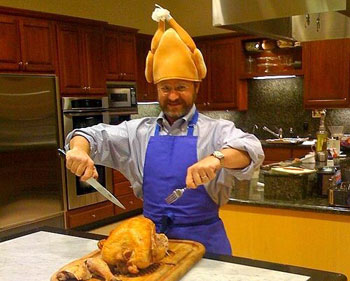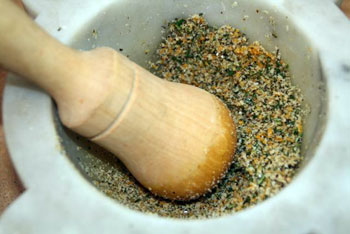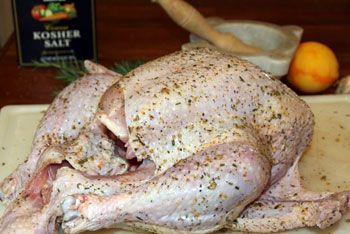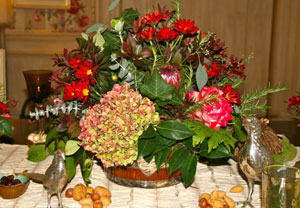 I’m grateful for many things at Thanksgiving– family, friends, health, light traffic on the 405…all the usual suspects. But as the person who hosts that gathering year after year, I am also grateful for this technique for a perfect dry-brine roast turkey that makes my old wet-brine birds seem spongy, bland and far too much work by comparison.
I’m grateful for many things at Thanksgiving– family, friends, health, light traffic on the 405…all the usual suspects. But as the person who hosts that gathering year after year, I am also grateful for this technique for a perfect dry-brine roast turkey that makes my old wet-brine birds seem spongy, bland and far too much work by comparison.
The method was developed by one of my favorite San Francisco chefs, Judy Rodgers. In her 2002 The Zuni Cafe Cookbook, Rodgers goes into great detail on why salting meats and poultry days ahead of the actual cooking promotes juiciness, texture and enhances flavor…flying in the face of what, until then, had been the conventional wisdom that the salting of meats should be done only at the last minute. Per her instruction, I tried it with dozens of dishes–from chickens to chops to pot roasts–and, in every instance, the technique worked beautifully. But it never occurred to me to use it on the all important Thanksgiving turkey until The Los Angeles Times’ Russ Parson, one of my favorite food writers, declared it the definitive way to beautify the bird. And, boy, was Russ right.
Since his first 2006 piece on The Great Turkey Smackdown, in which the winner was declared to be what he now calls “The Judy Bird ,” thousands of Angelenos have tossed their wet brines down the sink and have embraced the dry-brine method that Parson and the Times’ test kitchen staff have now perfected. Its popularity makes me feel a bit sorry for Russ…as every November he must feel compelled to re-publish the instructions and offer worthy improvements and variations , which, year after year, he has. (The variations detailed in the latter link span 3 pages, click on the “next” button at the bottom of each page to continue.)
You can also read Parson’s answers to the commonly asked questions about his Judy Bird, including how to brine and thaw it at the same time. But, just so you can wrap your head around this easy way of dry brining without a lot of reading, here’s a quick look at the basic technique.
(Note: If you’re cooking Thursday, you want this bird seasoned by Monday so that it has a full 3 and a half days in the fridge.) Rinse your turkey and pat it dry. Let it stand at room temperature for about an hour. (Though Parson doesn’t say that in every article, Rogers believes “the flavor absorption goes faster, simply because the osmosis/reverse osmosis goes faster at warmer temps.”.)
Rinse your turkey and pat it dry. Let it stand at room temperature for about an hour. (Though Parson doesn’t say that in every article, Rogers believes “the flavor absorption goes faster, simply because the osmosis/reverse osmosis goes faster at warmer temps.”.)
For every 5 pounds of turkey, you’ll use 1 Tablespoon of Kosher salt–so a 15 pounder will need 3 Tablespoons. If you’re adding aromatics (see below for details) you’ll mix those with the salt and grind together using a mortar and pestle or spice grinder.
Sprinkle a little salt inside the bird and rub the rest of the salt (or salt mixture) on the skin, concentrating a bit more salt over the thigh meat.
Put the bird in a sealable plastic bag, press out the air, close tightly and place it, breast side up, in a dish in the fridge. Chill for 2 days, then turn it over, breast side down, for the 3rd day. (On the second day, you can give it a little massage through the plastic to help work those juices and spices into the skin.)
If you’re cooking Thursday morning, late Wednesday night, take the turkey from the bag and put it back in the fridge, breast side up, for at least 8 hours. The air drying that’s helped along by your fridge fan will make the skin even crispier.
If you’re doing a smaller (under 15 pound) turkey, and want to cook it on a vertical turkey roaster, you can use it to stand the bird for the drying process. On Thanksgiving day, free the bird from the fridge and let sit at room temperature for about an hour before cooking.
On Thanksgiving day, free the bird from the fridge and let sit at room temperature for about an hour before cooking.
Preheat oven to 425 and roast, breast side down for 30 minutes. Turn the bird over, reduce the heat to 325. (If you’re using a vertical roasting stand there’s no need to move the bird, but you will still lower the temperature after the first 30 minutes.)
Roast the turkey until the temperature at the thickest part of the thigh is 165 degrees. A five dollar Instant Read Thermometer will take all the guess work out. But, in general, for a 12-15 pound bird, that means roughly another 2 hours and a half hours of cooking–more, obviously, for a larger bird. There’s no real need to baste (I know, I heard bells and whistles, too!) because the osmosis has ensured the meat will be moist.
Let stand 30 minutes before serving.
PLAY WITH YOUR FOOD
Thanks to the experimentation by Parson and Rogers, I now add other aromatics to the salt which infuse the bird with even more flavor. For example, try a rosemary citrus bird: for a 15 pound turkey, use 3 T of kosher salt, a T of chopped rosemary, 1 t of garlic and black pepper and the zest of an orange. Use a mortal and pestle to grind well.
For example, try a rosemary citrus bird: for a 15 pound turkey, use 3 T of kosher salt, a T of chopped rosemary, 1 t of garlic and black pepper and the zest of an orange. Use a mortal and pestle to grind well.
You can try thyme, oregano or bay leaves instead of rosemary, or use lemon instead of orange, you can try Indian spices or a BBQ rub. Once you have the basics of this simple technique down, you can really get creative and transform your turkey a new way each year!
Because this technique is so easy–and since the only work is done days ahead– it really frees you up to tackle other Thanksgiving preparations…Like setting the table and making some flower arrangements.
So give it try…I promise, when counting your blessings this holiday, you won’t forget the Judy Bird!
After 25 years as a local and network anchor, Lisa McRee was just another American mother struggling, and failing, to lose weight. Finally, she cracked the code, and lost 30 pounds, quickly and for good, by doing what she loves: reporting, cooking and eating! Visit The Skinny to see how she did it.